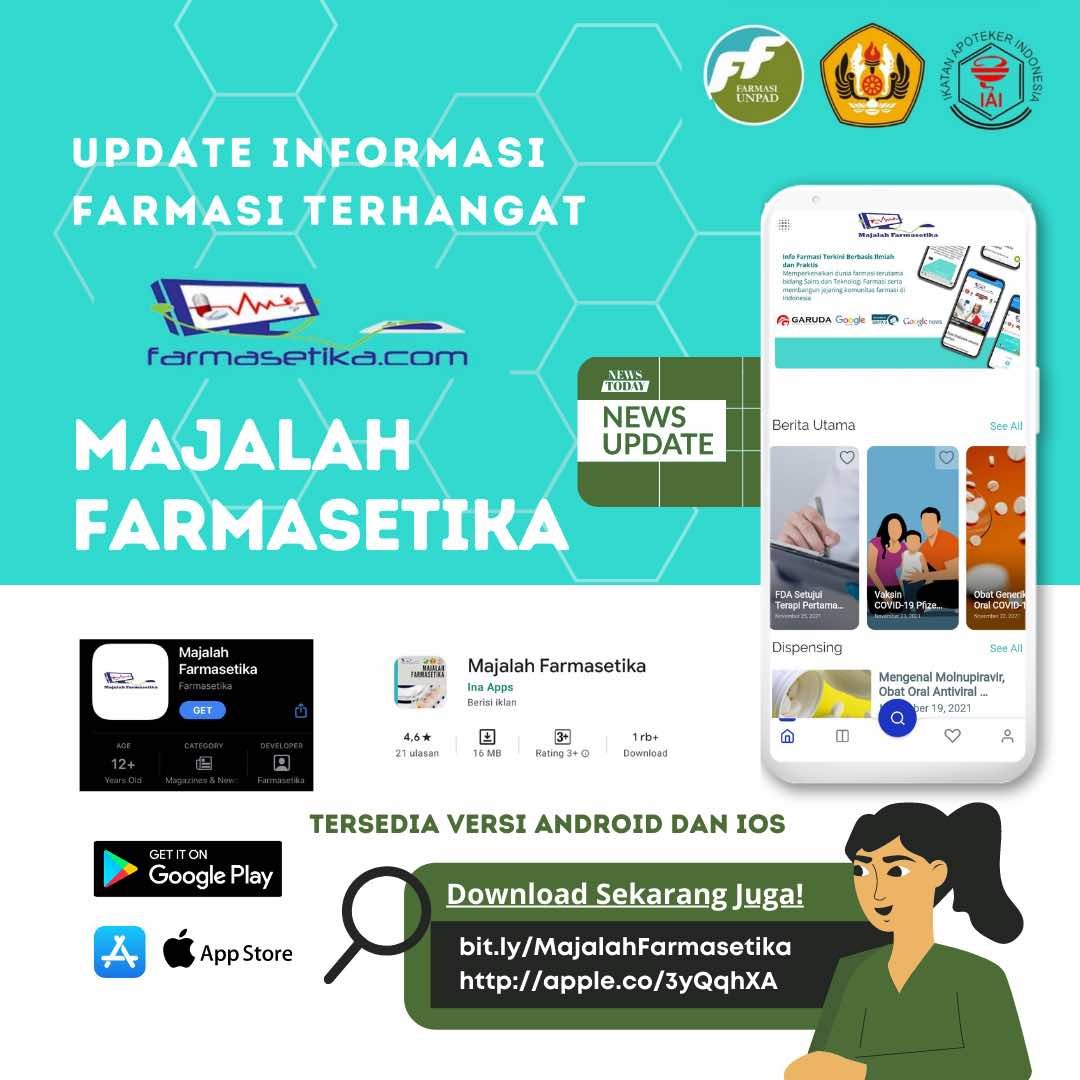Antimalaria Medicine and Its Mechanism : A Review
Abstrak
Malaria is a deadly disease caused by Plasmodium infection that is spread by female Anopheles. Malaria is a serious and deadly disease due to Plasmodium infection which is spread by female Anopheles mosquitoes. Among the five Plasmodium species, the most common species attacking humans are the Plasmodium falciparum and Plasmodium vivax species. Decreased sensitivity resulting in continuous and inadequate treatment, causing parasitic mutations, other than that allegedly originating from resistant areas. The purpose of this paper is to find out some anti-malaria drugs and the mechanism of action used in Indonesia based on references from the current development of anti-malaria drugs. While the benefits are providing information about antimalarial drugs and the mechanism of action in the use of drugs in Indonesia for malaria. Treatment of malaria is classified into 3, namely: classification of malaria drugs based on the workings of drugs in the Plasmodium life cycle, classification of antimalarial drugs based on the chemical structure of the drug, and classification of antimalarial drugs based on the workplace of the drug in the Plasmodium subcellular organelle.
Keywords: Malaria, Plasmodium, antimalarial, mechanism
Teks Lengkap:
PDFReferensi
Cui, L., Mharakurwa, S., Ndiaye, D., Rathod, P. K. & Rosenthal, P. J. 2015. Antimalarial drug resistance: Literature review and activities and findings of the ICEMR network. Am. J. Trop. Med. Hyg 93, 57–68.
Chandrashekar, V. N., Kishore Punnath, Kiran K. Dayanand, Rajeshwara N. Achur, Srinivas B. Kakkilaya, Poornima Jayadev, Suchetha N. Kumari, D. Channe Gowda. 2019. Malarial anemia among pregnant women in the south-western coastal city of Mangaluru in India. Informatics Med. Unlocked 15.
Cruz-Coke, R. 2016. World Malaria Report. Revista medica de Chile 101, 252-256.
Azlin, E. 2017. Obat Anti Malaria. Sari Pediatr 5, 150.
Hermanto, F., Iwo, M. I. & Asih, P. B. S. Thunb. 2013. Terhadap Aktivitas Antimalaria Artemisinin Pada Plasmodium Effect of ethanolic extract of clove (Eugenia caryophylata Thunb) as anti-malaria activity on Plasmodium falciparum 6, 94–99.
Muti’ah, R. 2015. Penyakit Malaria Dan Mekanisme Kerja Obat-Obat Antimalaria. Alchemy 2, 80–91.
Demissie, Y. & Ketema, T. 2016. Complicated malaria symptoms associated with Plasmodium vivax among patients visiting health facilities in Mendi town, Northwest Ethiopia. BMC Infect. Dis. 16, 1–8.
Fitriany, J. & Sabiq, A. 2018. Malaria. Jurnal Averrous 4.
Nguyen, T. H. Huy Nguyen Tien, Rahul Jain, Kaeko Kamei. 2007. 2-Tert-Butyl-8-Quinolinamines Exhibit Potent Blood Schizontocidal Antimalarial Activity Via Inhibition of Heme Crystallization. Antimicrob. Agents Chemother. 51, 2842–2847.
Mungthin, M., Na-Bangchang, K., Tan-Ariya, P., Kongthaisong, M. & Sinchaipanid, N. 2018. Comparison of the Bioequivalence of Three Oral Formulations of Dihydroartemisinin Based on Ex Vivo Blood Schizontocidal Activities Against Plasmodium Falciparum. Am. J. Trop. Med. Hyg. 71, 703–710.
Syamsudin. 2005. Mekanisme Kerja ObatAntimalaria. J. Ilmu Kefarmasian Indones. 3, 37–40.
Simamora, D. & Enggar Fitri, L. 2017. Resistensi Obat Malaria: Mekanisme Dan Peran Obat Kombinasi Obat Antimalaria Untuk Mencegah. J. Kedokt. Brawijaya 23, 82–91.
Zhang, J., Ma, W., Xie, B., Gui, J. F. & Mei, J. 2017. Beneficial effect and potential molecular mechanism of chloroquine on sperm motility and fertilizing ability in yellow catfish. Aquaculture 468, 307–313.
Aguiar, A. C. C. Erika Murce, Wilian A. Cortopassi, Andre S. Pimentel, Maria M.F.S. Almeida, Daniele C.S. Barros, Jéssica S. Guedes, Mario R. Meneghetti, Antoniana U. Krettli. 2018. Chloroquine analogs as antimalarial candidates with potent in vitro and in vivo activity. Int. J. Parasitol. Drugs Drug Resist. 8, 459–464.
Kementerian Kesehatan RI. 2007. KMK No. 044 ttg Pedoman Pengobatan Malaria.pdf. 1–10.
Khatri, P. Mansi K. Shah, Niketkumar Patel, Shashank Jain, Namrata Vora, Senshang Lin. 2018. Preparation and characterization of pyrimethamine solid dispersions and an evaluation of the physical nature of pyrimethamine in solid dispersions. J. Drug Deliv. Sci. Technol. 45, 110–123.
Deng, T. Shengjun Wu, Yalan Wu, Shiyou Hu, Huayu Bao, Xin-an Huang, Qin Xu, Zhaoli Yang, Jianping Song, Fang Liu. 2019. An unexpected Griess reaction on the important anti-malarial drug primaquine and its application for drug determination. J. Pharm. Biomed. Anal. 171, 8–14.
Lochner, M. & Thompson, A. J. 2014. The Antimalarial Drug Proguanil Is an Antagonist at 5-HT3 Receptors. J. Pharmacol. Exp. Ther. 351, 674–684.
Lawrenson, A. S., Cooper, D. L., O’Neill, P. M. & Berry, N. G. 2018. Study of the antimalarial activity of 4-aminoquinoline compounds against chloroquine-sensitive and chloroquine-resistant parasite strains. J. Mol. Model. 24.
Taylor, W. R. H. Widjaja, T. L. Richie, H. Basri, C. Ohrt, Tjitra, E. Taufik, T. R. Jones, K.. 2017. Chloroquine/doxycycline combination versus chloroquine alone, and doxycycline alone for the treatment of Plasmodium falciparum and Plasmodium vivax malaria in northeastern Irian Jaya, Indonesia. Am. J. Trop. Med. Hyg. 64, 223–228.
Peiris-Pagès, M., Sotgia, F. & Lisanti, M. P. 2015. Doxycycline and therapeutic targeting of the DNA damage response in cancer cells: old drug, new purpose. Oncoscience 2, 696.
Chhonker, Y. S. V. V. Bhosale, S. K. Sonkar, H. Chandasana, D. Kumar, S. Vaish, S.C. Choudhary, S. Bhadhuria, S. Sharma, R.K. Singh, G.K. Jain1, A.K. Vaish, S.P.S.Gaur, R. S. Bhatta. 2017. Assessment of Clinical Pharmacokinetic Drug-Drug Interaction of Antimalarial Drugs α/β-Arteether and Sulfadoxine-Pyrimethamine. Antimicrob. Agents Chemother. 61, 1–25.
Aucamp, M., Milne, M. & Liebenberg, W. 2016. Amorphous Sulfadoxine: A Physical Stability and Crystallization Kinetics Study. AAPS PharmSciTech 17, 1100–1109.
Zhang, C. J. Jigang Wang, Jianbin Zhang,Yew Mun Lee,Guangxue Feng, Teck Kwang Lim, Han-Ming Shen, Qingsong Lin, and Bin Liu. 2016. Mechanism-Guided Design and Synthesis of a Mitochondria-Targeting Artemisinin Analogue with Enhanced Anticancer Activity. Angew. Chemie - Int. Ed. 55, 13770–13774.
Meshnick, S. R. 2002. Artemisinin : mechanisms of action , resistance and toxicity. 32, 1655–1660.
Refbacks
- Saat ini tidak ada refbacks.











